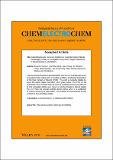Files in this item
Cobalt diselenide nanorods grafted on graphitic carbon nitride : a synergistic catalyst for oxygen reactions in rechargeable Li-O2 battery
Item metadata
| dc.contributor.author | Kumar, Surender | |
| dc.contributor.author | Jena, Anirudha | |
| dc.contributor.author | Hu, Yao Chong | |
| dc.contributor.author | Liang, Chaolun | |
| dc.contributor.author | Zhou, Wuzong | |
| dc.contributor.author | Hung, Tai-Feng | |
| dc.contributor.author | Chang, Wen-Sheng | |
| dc.contributor.author | Chang, Ho | |
| dc.contributor.author | Liu, Ru-Shi | |
| dc.date.accessioned | 2018-09-24T23:45:09Z | |
| dc.date.available | 2018-09-24T23:45:09Z | |
| dc.date.issued | 2018-01 | |
| dc.identifier | 251097808 | |
| dc.identifier | 384a7050-6a3f-4713-8ef0-4357710ee5d8 | |
| dc.identifier | 85030113788 | |
| dc.identifier | 000419042100004 | |
| dc.identifier.citation | Kumar , S , Jena , A , Hu , Y C , Liang , C , Zhou , W , Hung , T-F , Chang , W-S , Chang , H & Liu , R-S 2018 , ' Cobalt diselenide nanorods grafted on graphitic carbon nitride : a synergistic catalyst for oxygen reactions in rechargeable Li-O 2 battery ' , ChemElectroChem , vol. 5 , no. 1 , pp. 29-35 . https://doi.org/10.1002/celc.201700909 | en |
| dc.identifier.issn | 2196-0216 | |
| dc.identifier.other | Bibtex: urn:16611b48d4310f165774f51d0e421c1e | |
| dc.identifier.other | ORCID: /0000-0001-9752-7076/work/58054977 | |
| dc.identifier.uri | https://hdl.handle.net/10023/16074 | |
| dc.description | We gratefully appreciate the financial support from the Bureau of Energy (BOE), Ministry of Economy Affair (MOEA), Taiwan (105-D0114). C.L.L. thanks, Chinese Scholarship Council for financial support to his visit to St Andrews. | en |
| dc.description.abstract | CoSe2 nanorods are prepared via hydrothermal approach and characterized by using various techniques to examine crystallinity, crystallite size, morphology, and defects present within. CoSe2 is grafted on graphitic carbon nitride (g-C3N4) for oxygen reactions in a non-aqueous medium. Li-O2 batteries are assembled in dimethyl sulfoxide (DMSO) and investigated for charge-discharge cycles at various current densities. Li-O2 battery with CoSe2@g-C3N4 delivers 2158 mAh g−1 discharge capacity at 0.1 mA cm−2 current density. The charging potential of the Li-O2 battery is reduced by 280 mV in a combination of CoSe2 and g-C3N4. Electrochemical impedance spectroscopy (EIS) of the Li-O2 battery shows that charge transfer resistance of CoSe2 catalyst is reduced from 311 Ω to 181 Ω by adding g-C3N4. Tetra-ethylene glycol dimethyl ether also used as electrolyte to ensure better performing in terms of stability of the cell in comparison to DMSO electrolyte. Upon illumination of solar light without any redox mediator, the overpotential of charging step can be reduced. Under solar light illumination, the charging potential plateau shows a reduction of 330 and 170 mV in CoSe2 and CoSe2@g-C3N4 samples, respectively. | |
| dc.format.extent | 1586971 | |
| dc.language.iso | eng | |
| dc.relation.ispartof | ChemElectroChem | en |
| dc.subject | Cobalt diselenide | en |
| dc.subject | Graphitic carbon nitride | en |
| dc.subject | Metal-air battery | en |
| dc.subject | Photocatalyst | en |
| dc.subject | Rechargeable Li-O2 battery | en |
| dc.subject | QD Chemistry | en |
| dc.subject | NDAS | en |
| dc.subject.lcc | QD | en |
| dc.title | Cobalt diselenide nanorods grafted on graphitic carbon nitride : a synergistic catalyst for oxygen reactions in rechargeable Li-O2 battery | en |
| dc.type | Journal article | en |
| dc.contributor.institution | University of St Andrews. School of Chemistry | en |
| dc.contributor.institution | University of St Andrews. EaSTCHEM | en |
| dc.identifier.doi | https://doi.org/10.1002/celc.201700909 | |
| dc.description.status | Peer reviewed | en |
| dc.date.embargoedUntil | 2018-09-25 | |
| dc.identifier.url | http://onlinelibrary.wiley.com/doi/10.1002/celc.201700909/full#footer-support-info | en |
This item appears in the following Collection(s)
Items in the St Andrews Research Repository are protected by copyright, with all rights reserved, unless otherwise indicated.

